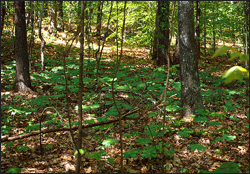Podcasts:
• 90 second podcast interview (1.7 Mb)
• 8 min. podcast interview (13.9 Mb)

From EarthSky:
Curtis Woodcock: The Landsat series of satellites really provide the backbone for the monitoring of forests that’s going on around the world.
Curtis Woodcock is a satellite researcher at Boston University. He studies changes to Earth’s forests using images taken from space with Landsat satellites. Woodcock says that the satellite records show that that today, some regions of Earth, such New England, are losing forests from development, while others,such as the Ukraine, are actually gaining forests when farms go abandoned.
Curtis Woodcock: The big changes have been mostly in the tropics, where there have been large areas that have been cleared, most of them converted for agricultural development.
He talked about changes to forests here in the U.S.
Curtis Woodcock: there have been substantial changes as people moved up to forests and cleared lots of land. Also, more recently, there have been lots of pest damage, probably as a result of climate change, through broad swaths of boreal forests. So that, and the fires that follow that, they have a very dramatic effect over very large areas of those forests.
How scientists track forest change with satellites is simple, said Woodcock.
Curtis Woodcock: Basically it’s not too hard. If you can produce a whole series of images, maybe one image from every year over a ten year time period, you can not only start to figure out where forests have been cleared, but also where they’ve started to regrow.
Dr. Woodcock explained why changes to Earth’s forests affect everyone.
Curtis Woodcock: Loss of forests can mean any variety of things, but mostly what we’re talking about are a whole range of something called ecosystem services. Those are things that forests provide to us without necessarily a whole lot of effort on our part. For example, they provide habitat to lots of species, and so biodiversity in many parts of the world is very dependent on forests.
A big issue at the current time refers to carbon. Global climate change is largely a result of increasing CO2 in the atmosphere, and forests are a natural sink for CO2 to store lots of carbon. So forests at this point in time can be either a source of CO2 to the atmosphere, meaning they can release CO2 to the atmosphere, following clearing and harvesting and that sort of thing. Or they can be a sink to CO2 from the atmosphere by absorbing atmospheric CO2.
Water’s another example. Forested watersheds are an excellent source of clean drinking water, so both quality and amount of water that’s returned to an area that we use for our purposes. Flood protection is another example. And it should be remembered that forests are an excellent example of a renewable resource, that wood products are an important thing that we derive from forests.
Source: Jorge Salazar, EarthSky [external link]
Further Information:
+ EarthSky [external link]

Scenes from the Polar Night
Landsat satellites have begun regularly acquiring images of ice at the poles during the winter, with enlightening results.





